Puffiness In Tomatoes: Why Tomatoes Are Hollow Inside


Tomatoes are the number one plant grown in the vegetable garden, but for many gardeners, they seem like they're number one with diseases and problems, too. Among the weird and unusual problems tomatoes develop are hollow tomato fruit and hollow plant stems. These two very different problems have different causes, even though they may look similar at first glance.
Why Tomatoes are Hollow Inside?
Tomato fruits may end up hollow if they weren't completely pollinated as flowers or something failed in early seed development. This happens for a variety of reasons, including improper temperature or excessive rains that may interfere with pollinator activity, or incorrect fertilization, especially when levels of nitrogen are high and potassium are low. Hollow fruits, also known as puffiness in tomatoes, can't be reversed in fruits already developing, but future fruits can be protected by doing a soil test before fertilizing. Environmental conditions that deter pollinators are difficult to control, but most puffy tomatoes disappear as the season progresses. A few special varieties of tomatoes have been bred to be hollow on the inside and shouldn't be mistaken for tomatoes suffering from puffiness. These stuffer tomatoes appear in a wide range of sizes, shapes and colors and often bear the words “stuffer” or “hollow” in their names. Varieties like Yellow Stuffer, Orange Stuffer, Zapotec Pink Pleated and Schimmeig Striped Hollow will always be hollow, despite your best efforts.
How to Prevent a Hollow Tomato Plant
When tomato plants are hollow, it's another situation entirely and very serious. The bacterial pathogen Erwina carotovora causes bacterial stem rot, a disease that results in the disintegration of the tomato stem pith. Tomato pith necrosis is caused by the bacteria Pseudomonas corrugata, but behaves similarly to bacterial stem rot. At the end of the day, these diseases are difficult to detect until the plant is too far gone to save. If your plants are yellowing and appear wilted, check the stems carefully for dark or soft areas. Areas that give easily or slough off during inspection are likely empty. Destroy these plants immediately to help prevent the spread of disease. In the future, plants need to be spaced further apart to encourage more air circulation and trimmed carefully. Lay off the nitrogen fertilizer, since pruning wounds are often the site of infection in bacterial stem-rotting diseases.
Gardening tips, videos, info and more delivered right to your inbox!
Sign up for the Gardening Know How newsletter today and receive a free copy of our e-book "How to Grow Delicious Tomatoes".

Kristi Waterworth was a regular contributor to Gardening Know How for many years, answering countless queries on plant pests and diseases.
-
 Never Plant Seedlings Until They Pass These 3 Simple Tests
Never Plant Seedlings Until They Pass These 3 Simple TestsDon't be over-eager to transplant seedlings into the garden before they are ready. These quick and easy checks will help ensure flourishing plants.
By Mary Ellen Ellis
-
 Grow ‘Karl Rosenfield’ Peony Plants For The Ultimate Frilly Border Beauties And Cut Flowers
Grow ‘Karl Rosenfield’ Peony Plants For The Ultimate Frilly Border Beauties And Cut FlowersFor frilly double magenta peony petals infused with a heady fragrance, grow ‘Karl Rosenfield’ peony plants. Here’s how to cultivate the ultimate plushy blooms
By Tonya Barnett